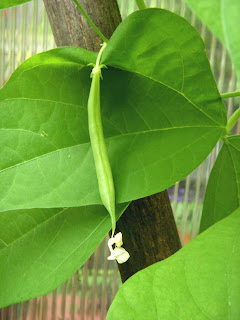
One may not know it, but now is the season for persimmons,
Diospyros kaki "Hachiya," so gorgeously pictured above, with leaves a dark glossy green, thick and large, making for stunning contrast to the bright orange fruit as it ripens. There is an American Persimmon tree,
Diospyros virginiana, as well, native to eastern United States north and south. So, really, they are not quite as exotic as they may sound.
Persimmons may be eaten fresh off the tree, especially if you happen to be lucky and grow the non-astringent "chocolate" type. Otherwise, it would be wise to let the fruit ripen, preferably on the tree, not to be picked till it's on the verge of frostbite, especially if you have the native
D. virginiana, or D. texana.If you've ever eaten a persimmon picked at the wrong time, or not properly ripened, and experienced intense mouth puckering, let me plead with you not to give up yet on this beautiful fruit. Blame the tannin. This is the substance which underlies the ones that are classified as astringent.
But really, think about making persimmon scones, or better yet, call them
jumbles - this more readily connotes fun and games. Apparently it is quite a southern delicacy. And do use the oblong asian Hachiya variety (as opposed to the round and squat asian Fuyu ones,) if you can. They're available from greengrocers this time of the year - and now you know what they look like. One does not need to plant a tree, the tree is the bonus.
One does need
two really, really ripe persimmons - so ripe they are exceedingly soft, the skin practically translucent. Wash the fruits, keeping the skin on, discarding the stems. Cut up and puree persimmons in a food processor or blender until smooth, you should get about
2 cups of pulp.
Note: If you're lazy, or bereft of kitchen electricals, you can buy persimmon pulp already sweetened, and so skip adding the cup of sugar too. I'm sure Google can tell you where to buy online. This paragraph is written as a concession to civility; I hasten to remind all that we're on a gardening blog. It is enough that I let you buy the fruits from a store.Preheat your oven to 375 degrees Fahrenheit. Use 2 large cookie sheets, buttered or lined with parchment or those new silicone liners.
Sift
3 cups of unbleached flour, 1 tsp. baking soda, 1/2 tsp. each of ground cinnamon and allspice, 1/8 tsp. of nutmeg, and 1/4 tsp. salt together.
In a larger bowl, with an electric mixer, beat
8 tbsp (1 stick) unsalted butter and 1 cup sugar until light and frothy about 2 minutes. Beat in
1 large egg. Fold in the
2 cups persimmon pulp. Stir in the flour mixture, making a soft dough. Finally, mix in
1 cup chopped walnuts and 1 cup currants. You can also use
dried cranberries instead of currants. I did.
If you prefer cookies to scones, use one cup less, each, of
flour and mashed persimmon.
Drop a scant tablespoon of dough, each about 1-2 inches apart on cookie sheet. Bake 12 to 15 minutes, or until lightly brown. You should get about 24 -30 smallish tidbits.
I won't tell you that you'll have to take the jumbles out of the oven, let them cool by whatever method you prefer, and either eat them yourself, or share them with others - whatever you deem fit.
I think you'll like them.

 In the waning days of the year, I return to fulfill a promise made in one of my earlier posts, http://a-gitate.blogspot.com/2008/09/why-gitate-and-in-city-no-less.html - to the story of how a flower, albeit not your common everyday garden-variety flower, beguiled a bee to the very end.
In the waning days of the year, I return to fulfill a promise made in one of my earlier posts, http://a-gitate.blogspot.com/2008/09/why-gitate-and-in-city-no-less.html - to the story of how a flower, albeit not your common everyday garden-variety flower, beguiled a bee to the very end. But the bees. The bees - they love the passion flower. Yes, yes - what's not to love? One asks.
But the bees. The bees - they love the passion flower. Yes, yes - what's not to love? One asks. Do not be sad, dear reader, for the passionate bee and his lovely flower mate will return next summer. I promise.
Do not be sad, dear reader, for the passionate bee and his lovely flower mate will return next summer. I promise.











































